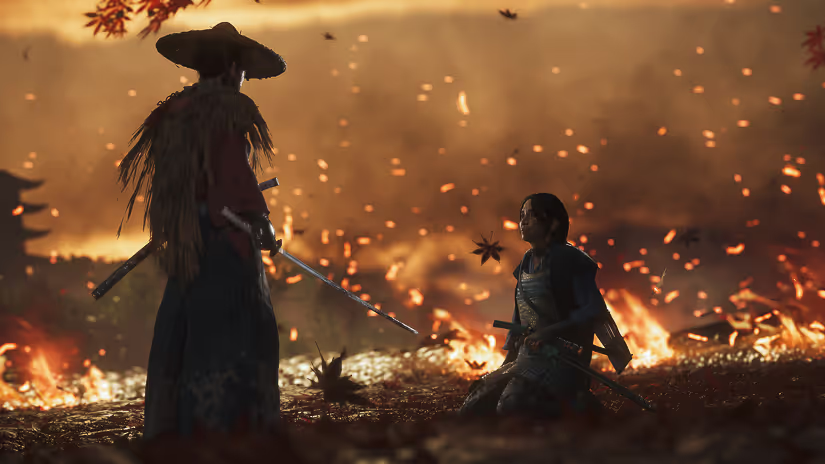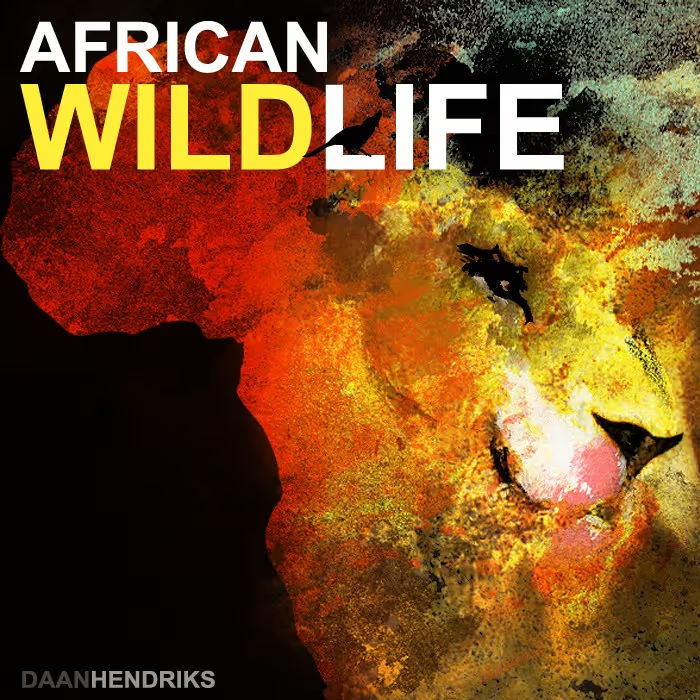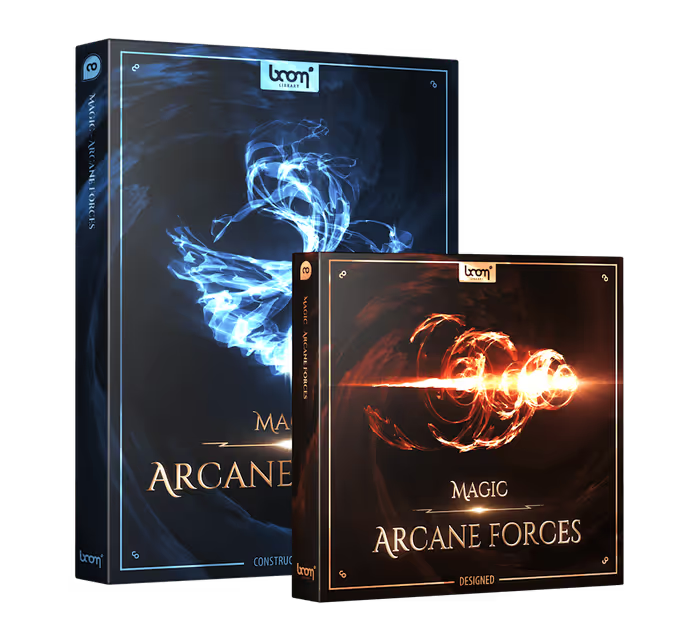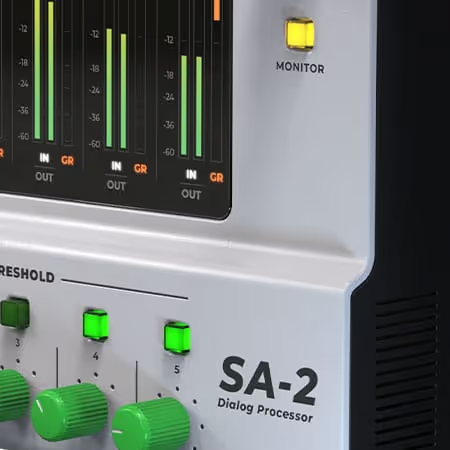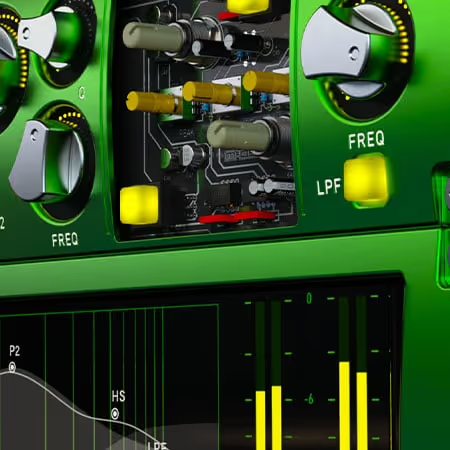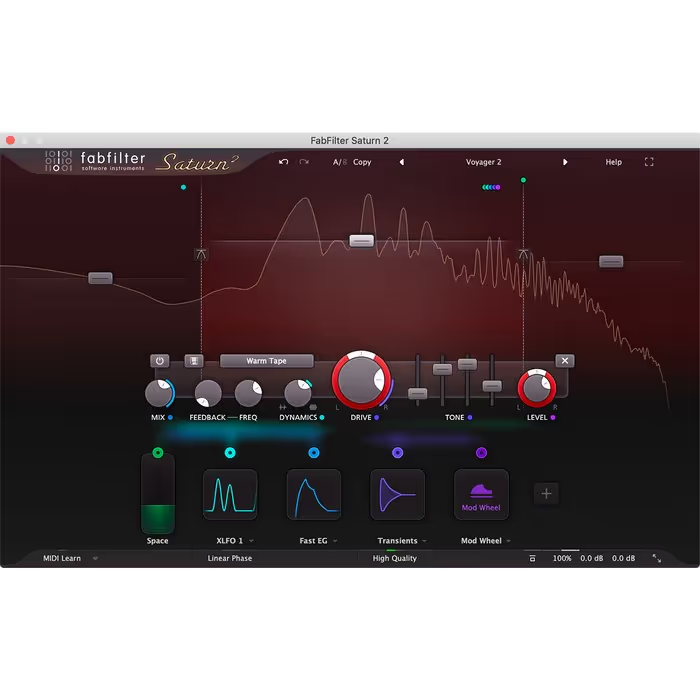Authenticity and subtly in sound make Ghost of Tsushima a combat game that’s both brutal and beautiful. The Sucker Punch sound team — led by Rev. Dr. Bradley D Meyer, Audio Director, and Josh Lord, Senior Sound Designer — intensely researched 13th-century Japan and samurai culture before seeking out potential sound sources to record. These curated sounds convey the reverent tone of game’s story — historical-fiction based on The Mongol invasion of Japan in 1274.
Here, Meyer and Lord talk about those fascinating sources — from Tancho birdsongs and barks and growls of Tibetan Mastiffs to a horagai (a conch shell signaling horn used by the samurai) that’s used in a yearly ceremony on Tsushima Island to commemorate the Mongol invasion and battle at Komoda Beach.
Plus, they discuss the technical challenges of creating sound for the game, from designing audio features to handle occlusion and reflections, to building a sophisticated procedural ambience system that allowed their small sound team to handle this massive game audio project.
Ghost of Tsushima | Story Trailer | PS4
If you had to pick three adjectives to describe the tone of Ghost of Tsushima, what would those be? How does your sound palette reflect/reinforce that tone?
Rev. Dr. Bradley D Meyer (BDM): Grounded — This is not a fantastical game, so our design was really steeped in grounded and organic sound design.
We spent lots of time throughout development recording real-world sounds which became our palette we used from ambience to combat to UI. Some examples are fairly obvious, like nearly all of the wildlife sounds were recorded in Japan. Another example is the sword sheathing/unsheathing sounds. Early in the project we found an iaido (Japanese swordsmanship) school near our office so we attended some classes and what really struck me there was both how silent a katana is when in the hands of a master (obviously we had to steer more towards cinematic expectations here), but also in learning the correct way to sheathe and unsheathe a blade, I knew I wanted to present that accurately rather than go with a more stylized metallic shing. It just makes the katana, which is really an extension of a samurai’s hand, feel more part of the world.
Aspirational — One of our internal pillars for this game was that it should be a time machine that makes the player feel like they’re a samurai in 13th-century Japan. We wanted the world to really feel like that. The natural beauty really needed to sing, whether that was the tranquility of birdsong on a clear day or the torrential threat of a looming storm. The wind — which plays a very strong role in the game as the main navigation tool — also needed to make the world breathe with its dynamism across weather states and biomes. Safar Bake, one of our sound designers, did a great job there.
The natural beauty really needed to sing, whether that was the tranquility of birdsong on a clear day or the torrential threat of a looming storm.
Even without the characters, we wanted the world to feel truly alive and I think the natural dynamics we built into our ambience systems really make both the island itself and the wind feel like two of the main characters of the game.
Intimate — This is perhaps most closely related to combat, where we wanted it to both feel and sound dangerous. These are essentially 2-foot long razors you try to attack your enemy with, in fairly close quarters. It’s serious and intense stuff. We really wanted to focus on the danger of combat and make it feel like you’re taking a risk when engaging an enemy. We recorded a lot of source to create a palette of sounds for the weapons that felt both grounded and intimate.
The intimacy can also be heard in the more subtle details of the game, from hearing the shoji doors rattle in the wind to the creaks of more rickety structures when the player walks on them or the settling of an abandoned or burned-out building. A lot of the peasants in the world are doing really simple jobs: picking rice, cleaning tea leaves, weaving baskets, and if you get up close to them you hear all that detail.
Also in character Foley, one of the characters, a warrior monk named Norio, has beads, rice balls, a horagai, and even a bell as his gear, and their sounds are all in there as he runs around. Same with the sloshing and bamboo wicker creaks of Kenji, our sake merchant. Hero and horse breathing changes dynamically based on fatigue and injury.
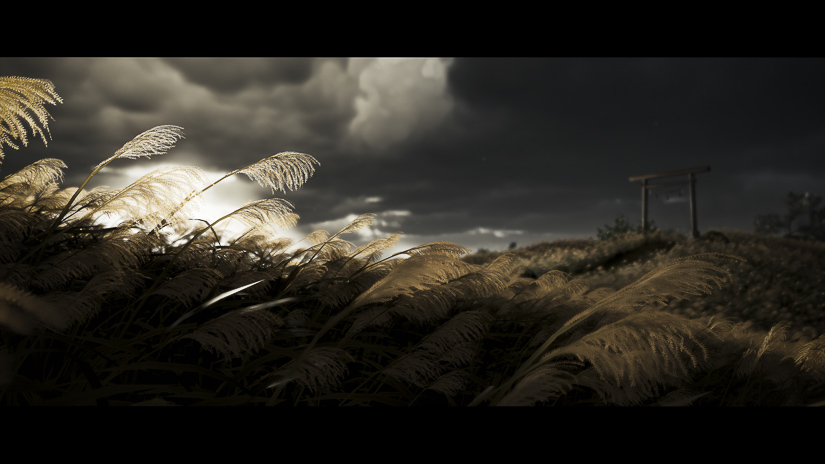
The score is a powerful aspect of this game. How did the score influence your approach to the sound design? Were you able to work against temp music tracks while designing the sound?
BDM: The systems were built fairly separately, but there was a lot of thought put into how things would sound based on what was going on in the world and the types of music playing at any given time. For example, when exploring, we have occasional, really beautiful, fairly sparse music cues that can play, and this is really when the wildlife and ambience is loudest in the mix. When the player is infiltrating a Mongol encampment, we bring down the Foley and ambience a bit so the player can feel the tension of the music better, and when you’re in combat and the music amps up a little, that’s also when we bring the combat sounds more present in the mix.
…when exploring, we have occasional, really beautiful, fairly sparse music cues…
We also built a system of elaborate mix states throughout every mission and all of the systemic world changes and we use those to constantly balance the mix of sound design, music, and dialogue.
We often worked with temp music throughout the project before we had our final tracks and were fortunate enough that most of our temp music came from the two composers who scored the game, so early on the music was different but the core tone and feeling were still conveyed, and then we were able to swap this out with the demos from the composers fairly early. This helped us shape core aspects of some key emotional beats of the game, determining when to let music drive the experience and when to focus more on sound design.
There are a few big emotional moments in the game that I don’t want to spoil that involved a lot of experimentation and play between the music and sound design to dial in just right.
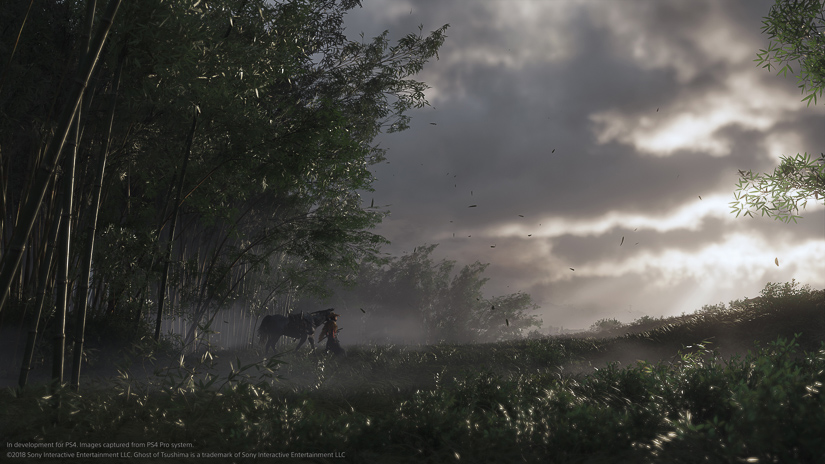
Exploration: How did you use sound to help guide and draw the player towards different areas of the island? (What did you do sound-wise to help lure the player to explore new places?)
BDM: Probably the biggest sonic attractor in the game is the guiding wind. On the sound side, we built a system where the sound travels on three splines pointing towards the player’s current objective, one centered over the player and one on either side spaced about 5 meters away. The player can also call a single gust of wind at any time which also travels along these splines. These wind gusts are all reactive to the current environment the player is in. So if you’re skirting a grassland on one side and a bamboo forest on the other, the wind will sound like tall grass rustling on your one side and clacking bamboo on the other. This directionality helps players key into where they should be headed as they traverse the island.
Another element is our diegetic music. We use this for key aspects to help the player hear things from afar and give them motivation to explore…or avoid! We were fortunate enough to work with the Tuvan musician Radik Tyulush so you may hear Mongols singing, drumming, or playing the morin khuur when you’re near a Mongol encampment. Similarly, you may hear the strumming of a biwa, which you can use to find a storyteller to lead you on a new exciting quest.
…you may hear Mongols singing, drumming, or playing the morin khuur when you’re near a Mongol encampment.
We even use music non-diegetically in some cases to help the player know where they are. Music cues that play as you approach a shrine, pillar of honor or other mini-discovery helps to drive the player to these content sites and make it clear when they’ve arrived at new content.
Another area we use sound to help lead the players through the world is via our wildlife. Japan has so much amazing wildlife and we carefully chose certain species to help lead the player. The guide bird — the black and yellow bird which will take the player to various objectives and collectibles — is a Black Naped Oriole and it was chosen for 3 reasons: it could be found in Japan, it was visually unique, and I was fortunate enough to record one when I was on vacation in Sri Lanka in 2018. The foxes — which guide you to small shrines — is another example where you can hear their howls and yips from afar which serve as a beacon. You know they’re near so it’s up to you to find them and follow them to their shrine.
Similarly, you may hear the strumming of a biwa, which you can use to find a storyteller to lead you on a new exciting quest.
Lastly, the ambient sounds help reflect where the player is in the world. The dense forests of the southern part of the island, Izuhara, have the lushest biophony with regards to birdsong, while moving into the wetlands of Toyotama introduce a lot more amphibians and very specific birds, like the Tancho (the red-crowned crane), that are keener to hang out in wetlands and broad grasslands. Finally in the northern climes of Kamiagata, where it’s colder, higher elevation and snowy, you’ll hear a lot of black kites and the bird song really becomes sparser. We also did some research about what the sound absorption properties of snow were and we did some subtle EQ work to help make that area feel distinct.
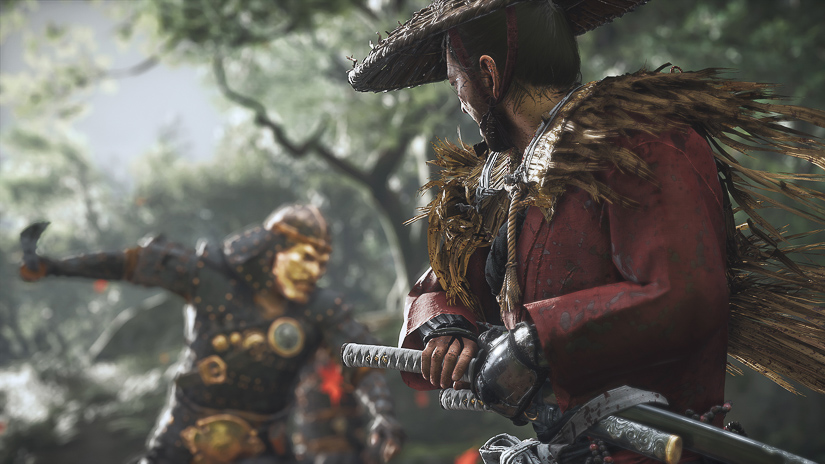
Combat: When designing sounds for combat, how did you help distinguish Jin fighting as a Samurai versus Jin fighting as a Ghost?
BDM: This was largely based on the mechanics. When Jin is fighting as a samurai it’s all about swordsmanship, so the audio is all about the katana sounds and character Foley. For Jin’s Ghost techniques he’s often sneaking around so we dial the Foley back a bit and push the more visceral aspects of those weapons and the quick kills Jin generally executes as the Ghost.
The Ghost tactics were also where we took a bit of creative freedom away from our grounded tone, adding stingers and sweeteners to make those feel more unique. Our sound designers Mike Niederquell and Andres Herrera did a fantastic job making each of these combat techniques feel unique yet cohesive.
 Tesla Model X 2015 electric full size crossover SUV sport utility vehicleKrampfstadt Studio65,00 $32,00 $51% OFF
Tesla Model X 2015 electric full size crossover SUV sport utility vehicleKrampfstadt Studio65,00 $32,00 $51% OFF
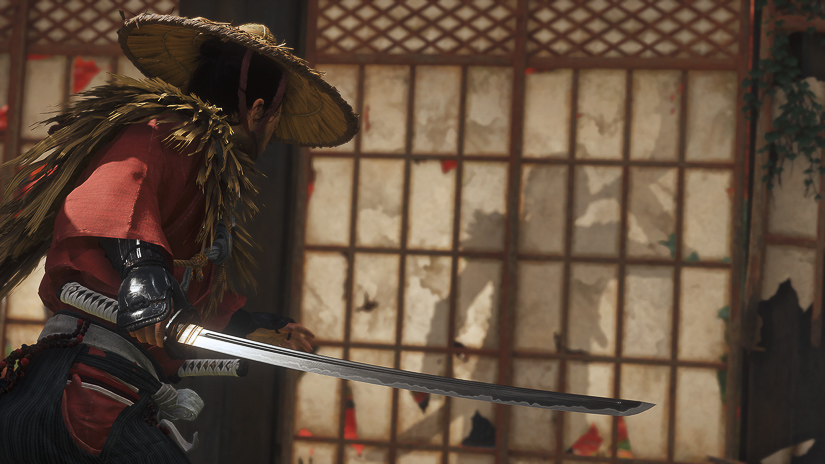
Sword, knives, and bow/arrows are the main weapons for combat. Can you talk about asset creation for the weapons? Did you record new sounds? Any fun field recordings? Library sounds? Foley for added detail?
BDM: We recorded a ton of new source for the weapons, and really most everything in the game.
For the weapons specifically, we were fortunate enough to borrow a bunch of sword blanks from the Sony PD Sound team. They sent up this huge box of sword blanks they’d used for God of War and Josh and I spent a lot of time recording them in all manner of ways from scraping them against each other, clanging them together, swinging them, suspending them from the ceiling and spinning them around to get interesting resonant tones, etc.
I…had a katana and wakizashi custom made (complete with “Ghost of Tsushima” engraved in kanji on the blade) so I could record them, and then beat them up against the other sword blanks.
I mentioned the sheathing and unsheathing of the katana earlier and had a katana and wakizashi custom made (complete with “Ghost of Tsushima” engraved in kanji on the blade) so I could record them, and then beat them up against the other sword blanks.
For impacts, because we wanted to really emphasize the razor qualities of the katana, Josh and I spent a lot of time recording all sorts of blades, from knives and bayonets to razors and box cutters slicing through all manner of fruits, vegetables, and cloth to capture the ripping of flesh, armor and sinew in a very forward but not overly exaggerated way.
Our amazing sound designers at Sony — Mike Niederquell and Andres Herrera — then took all these assets and added that layer of polish and really make them sound fantastic.
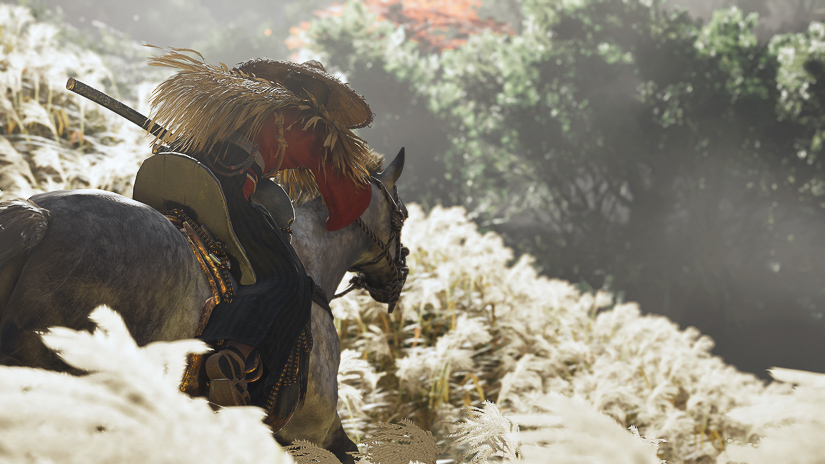
You mentioned the character Foley. What were some other key Foley sounds that were created for the game?
BDM: There’s so many!
We were fortunate enough to record a lot of character Foley with Alyson Dee Moore, Chris Moriana, and John Sanacore at Warner Brothers, but Josh and I did a ton more character Foley in the studio as well.
We took apart straw and bamboo mats, bought some Japanese yukata and jinbei, as well as footwear like waraji, and incorporated all of that into our recordings. Some of the higher-skilled Mongols had some fur in their costumes and for that we used a possum pelt that I got in New Zealand years ago. I even researched and made a bunch of boiled leather armor panels as well as paper armor. Although the game is not wholly historically accurate, in the 13th century, the samurai used largely paper armor (much stronger than it sounds, it was many, many layers thick). But Mongols had this technologically advanced boiled leather armor which was more resistant to blades and arrows. Fun fact about boiled leather is that you don’t actually boil it, but cook it at 180 degrees and it gets super hard.
We took apart straw and bamboo mats, bought some Japanese yukata and jinbei, as well as footwear like waraji, and incorporated all of that into our recordings.
I bought bamboo poles from a wholesaler and we used that for the bamboo sword cutting mini-game, surfaces, our various bamboo structures in the world, and even parts of the UI. By the end of the project we had bamboo poles in all sorts of states from pristine to splintered shreds and remains.
The warhorns were another fun one. We were fortunate enough to have a group travel to Tsushima for the ceremony they do every year commemorating the Mongol invasion and battle at Komoda Beach. As a signaling horn, the samurai used a conch shell called a horagai, so we recorded their horagai from this ceremony and were able to use that in-game. For the Mongols, I bought a giant steer horn and taught myself to blow through it properly to make noise and that became the Mongol warhorn. I’ll post embarrassing videos someday soon.
Hamidreza Nikoofar’s in-depth conversation with Ghost of Tsushima Audio Director Bradley D. Meyer
That was an interesting part of the recording for this game: compared to our last title inFamous Second Son, which was a largely fantastical super-power focused experience, nearly all of the source we recorded for Ghost was much more literal. We still made a lot of creative choices and did lots of creative design with our Foley source, but there was also this sense that a lot more of our Foley had a much literal translation from performance and recording to how it ended up sounding and playing back in game. Although I guess I should admit there are peasants in the world who are polishing rice, but I actually used barley to record that sound, so I guess we’ll get some demerits in the authenticity category there! :-)
[tweet_box]Crafting ‘Ghost of Tsushima’s Tremendous Sound[/tweet_box]
I had to do a horse recording session by myself at a natural horsemanship center up here which proved challenging and at times hilarious, but Josh, Adam Lidbetter, and Rob Castro all whipped that content into shape and made the horses sound absolutely fantastic.
Another fun recording trip was when Josh and I found a local Tibetan Mastiff breeder (the actual breed used by Mongols) called Dreamcatcher that let us come record their dogs. They were terrifying and gave us such great recordings. And after they were done barking and growling, they turned into the biggest fluffballs of love. Not sure if we ended up getting more petting or recording done that day.
And after they were done barking and growling, they turned into the biggest fluffballs of love.
Both Mongols and Japanese sleep in the game, so I had to add occasional snoring to help signify that to the player. Note: people should know not to fall asleep near a sound designer if they snore. The Mongols are actually Nate Fox, our game director. We shared a room at the Game Developer’s Conference once and when I came in one night, he was passed out and snoring LOUD, so, you know I had to do my field recording duty. The male peasants are the superintendent of schools for Mount Shasta, California. And the female peasants are my partner, Bonnie. She told me if I ever recorded her snoring, we were breaking up, but her snores were amazing, so of course, I recorded them; I just didn’t tell her. Then one day, she mentioned how much she’d love to be in the game, even her snoring. After questioning if it was a trap, I told her she’s in there!
Lastly, when I was in Japan doing field recording in December of 2017, Bonnie and I had hiked up the side of a mountain and I set up my rig to record mountain birdsong and walked 20-meters away. We were waiting quietly there when all of a sudden, we heard this crazy piercing alarm-like sound. We both looked at each other and mouthed, “What the f*ck was that??!?!?” I thought we’d somehow tripped an alarm or something. We heard it again and then we saw two big sika deer run by and take off. They continued to bleat their calls for another 15 minutes and that was perhaps the happiest surprise recording of the project. In addition to some fantastic source recorded by Thomas Rex Beverly, those deer are in the game!
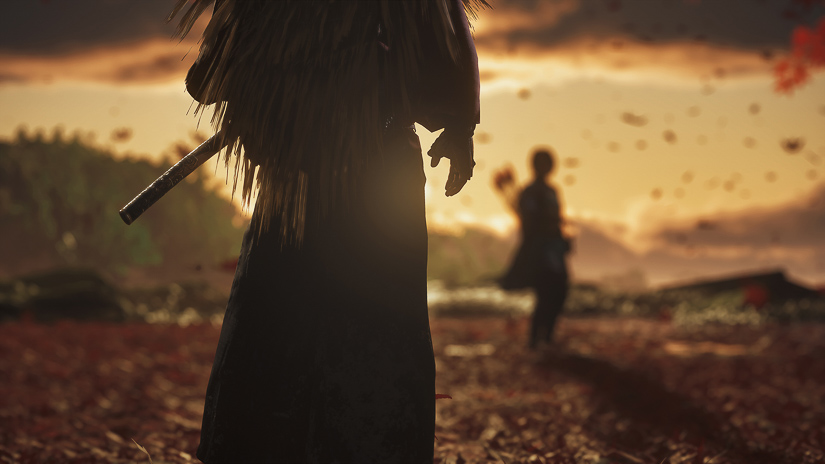
UI/UX Sounds: What was your aesthetic approach to the UI/UX sounds, and what sound tools were helpful in creating these sounds?
BDM: For the UI/UX stuff our goal was to maintain consistency in tone with the rest of the game. To help ground the UI in the game, we opted to use organic sounds, but per direction from our creative/art director Jason Connell, we tried to make it a bit dark. So we started with a bunch of source we’d recorded from paper, our sword blanks, and a bunch of musical instruments and then Josh Lord, who really owned the whole sonic identity of the UI, processed all of that into a ton of different source. I’ll let him talk more about his process…
I created a Max/MSP patch that is useful for all sorts of design tasks…
Josh Lord (JL): Early in the project, we had a stand up with Co-Creative Director Jason Connell where tone and emotional notes were discussed for the UI aesthetic. He wanted the UI to mirror Jin’s journey and convey the sorrow and heaviness that is felt while protecting his people from brutal foreign invaders. This was still early in the project and a lot of visual UI elements had yet to be designed, so I started by creating a palette of UI sounds that we could modularly build from. The obvious choice for source in a game with katana combat would be big resonant sword hits or shings but we needed something more subdued and moody for the majority of UI. We ended up recording a lot of the bamboo, wood, paper, and stone props we had available in our Foley racks. In addition to those recordings, one of our composers, Ilan Eshkeri, sent over his recordings and source that he used for the score. Using a modular approach for assets was particularly useful and time-saving at the end of the project when UI became rapidly finalized.
…building my own allowed me to customize the effects chain and playback randomization as needed.
For processing the source, I created a Max/MSP patch that is useful for all sorts of design tasks but it was particularly useful for UI on Ghost of Tsushima. It’s essentially a “happy accidents” generator similar to Wave Warper or S-Layer, but building my own allowed me to customize the effects chain and playback randomization as needed. The most useful feature of the patch was the ability to print out the last 15 seconds of the buffer with a key command. This allowed me to let the patch run in the background and when something surprising or unique was generated I could print out just that asset instead of needing to dig through hours of recordings later on.
Highlights from A Sound Effect - article continues below:
Dialogue: Players can choose a Japanese voicetrack option (with subtitles), or choose an English voicetrack. What were some challenges in making the different language tracks fit character lip sync?
BDM: Our dialogue and localization teams are pretty incredible when it comes to dialogue matching so all credit is due to them. For in-game dialogue, the lip sync is procedurally generated based on the amplitude of the wav files and the blending of facial visemes based on a key set of phonemes. For our cinematics, where we actually used cameras to capture the English voice actors, our localization team translated and edited dialogue to within 0.1 seconds of the original (English) dialogue.
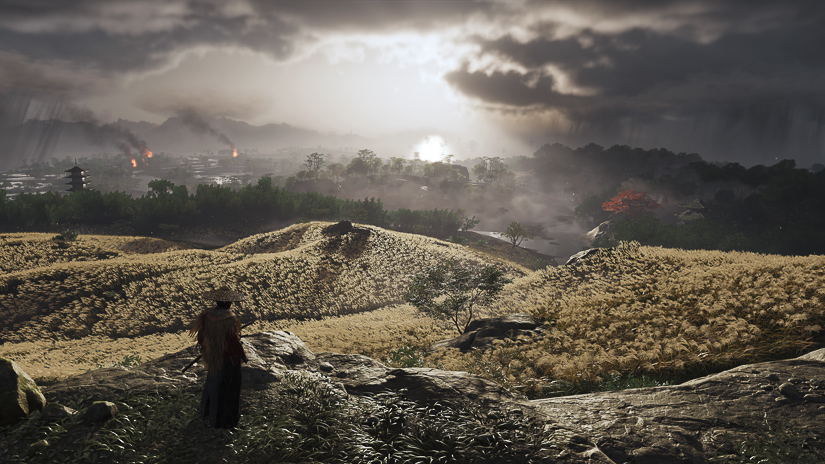
What was your biggest technical challenge in creating the sound of Ghost of Tsushima?
BDM: Ghost of Tsushima was so much bigger than our last game, but obviously our studio did not grow in person-power by the same rate. So the biggest hurdle for us collectively was how to work smartly so that we could pull this off. Credit is due to our programming staff who created a really robust set of tools that allowed us to build the world, missions, and everything you see in a smart way.
I was fortunate enough to work closely with one of our programmers, Apoorva Bansal, who was instrumental in giving us the audio features we needed from occlusion to reflections to a very sophisticated procedural ambience system.
In the past we hand placed all of our emitters in the world, and with a game the size of Ghost, that would not be possible, so with Apoorva’s help it became a much simpler, data-driven process where we control what species play when, where, and how often.
We had to be smart about how we designed systems and implemented assets to ensure that they worked in all biomes and scenarios in the game.
It’s a really awesome system and I hope to give a talk about it soon because I think it really demonstrates what we were trying to do: empower ourselves to work smartly and efficiently through the development of a well defined and robust toolset.
JL: The size of the world we were creating made it increasingly likely that there were areas of the game that might not be seen or get adequate coverage by the audio team. We had to be smart about how we designed systems and implemented assets to ensure that they worked in all biomes and scenarios in the game. We still wanted the game to feel as though sounds were bespoke to each location and mission, but we needed to carefully balance that desire with the realities of a large open-world game. There are areas where we wanted to pay special attention to sonically, like in missions or the shrine climbs, where there are hand placed emitters and volumes, but much of the soundscape relies on the procedural ambient system.
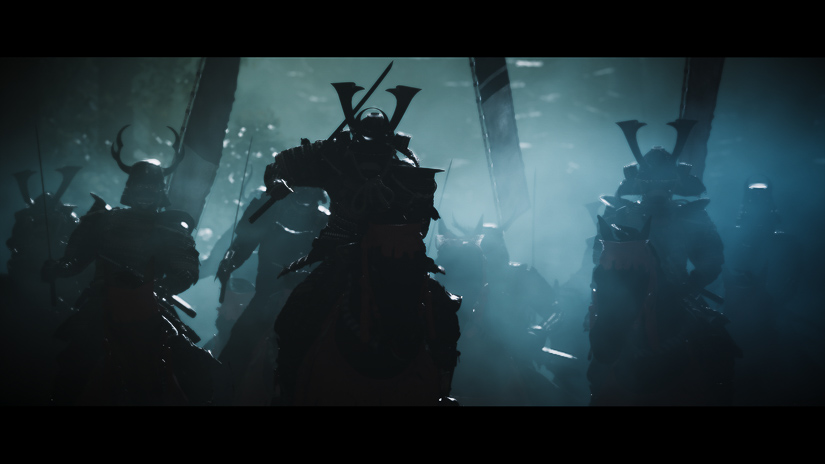
What about your biggest creative challenge?
BDM: In my 22+ year career, Ghost of Tsushima is the first original IP I’ve helped build from scratch. Creating a brand new world from nothing is both the most exciting and enticing aspect, but it’s also exceptionally challenging.
Jin Sakai did not exist before we created him. His outfits, his fighting style, the way the animals interact in the world, the guiding wind, the messaging to the player, the way Jin can have a showdown or face an enemy in a duel: all of these things were brand new and needed a unique sonic identity.
Creating a brand new world from nothing is both the most exciting and enticing aspect, but it’s also exceptionally challenging.
I feel so fortunate to have been given the chance to play a role in developing the identity of this new IP, but it was also very challenging because not only did we want it to sound great, but we also wanted to present our work with respect for the subject matter and the culture we were representing. Really this boiled down to doing A LOT of research. We read books about the Mongol invasion, about feudal Japanese society, the samurai class, famous samurai of the feudal period (if not all the way back to the Kamakura era when our game takes place). I even found a fascinating book by a 13th-century Franciscan monk who traveled from Italy to Mongolia to sit at court with the Mongols that went into fascinating detail about their culture and society. We watched films, played games.
Sending a few teams to Japan and being fortunate enough to go there myself was also an immense learning experience. To hear, touch, and smell these vestiges of this world definitely helped inspire us in countless ways. I think all of these things were necessary to really understand the world we were building and to use all of that to help sculpt this world from nothing.
…we needed to make the navigational guiding wind gusts unique and stand out amongst the environmental wind to ensure there wasn’t confusion on part of the player.
JL: Wind plays an important part in the story. It was a pillar in the visual language and is the main navigational mechanic in the game. We needed to support everything from gentle breezes to full-on blizzards all while keeping the mix clean and minimizing a buildup of white noise.
In addition to keeping the mix clean, we needed to make the navigational guiding wind gusts unique and stand out amongst the environmental wind to ensure there wasn’t confusion on part of the player.
I also wanted the guiding wind gusts to have a vocal quality to them to convey a sense that the island itself is carefully guiding the player around to repel the Mongols. It was important to not imbue the gusts with a magical quality or have an overt vocal layer. We tried various elements but settled on recordings that Brad and I did with a bamboo flute. When played imperfectly, the flute was able to produce some interesting tonal layers that still had a breathy/windy quality to them. These additional layers allowed the guiding wind gusts to stand out amongst the rest of the wind in the mix.
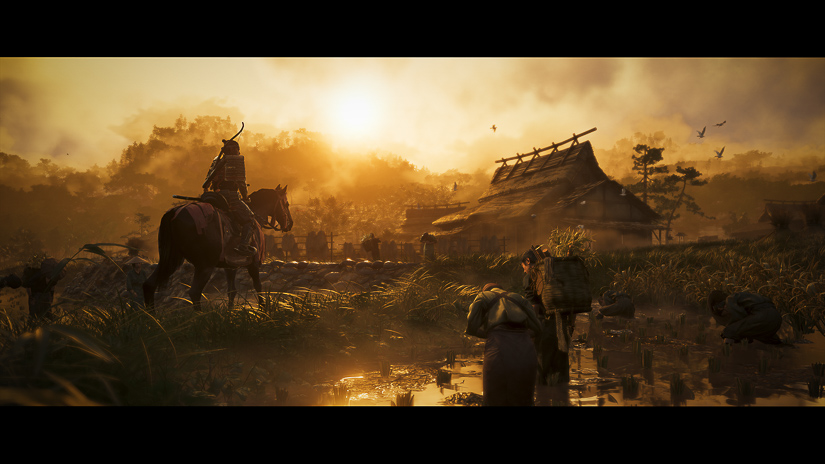
What are you most proud of in terms of sound on Ghost of Tsushima?
BDM: Without question, I’m most proud of the team. For much of production, the Sucker Punch team was three people: myself, Josh Lord, and Michelle Thomas, with the addition of our amazing music and voiceover teams from PlayStation.
Towards the end of the project, we had immense help on the sound design side from PlayStation and were also able to bring in another implementer, Tye Hastings, and technical sound designer, Michael Pitaniello, and that’s where everything really started to come together.
We spent the first couple of years building the systems and trying to create a workflow where we could bring people on later in the project and they could easily iterate and integrate their work into the game. The entire team just did a fantastic job of making Ghost the cohesive experience it became.
Special shout out to Glen Gathard and the fantastic team now at Molinaire, who did our cinematics and again really helped to blend those transitions from gameplay to cinematic to make the experience as seamless as we could.
Much like Ghost as a game, I think the audio turned out as well as it did because this entire team came together and everyone did really phenomenal work.
There is a meditative quality to the soundscape and I often catch myself leaving Jin in an open area and putting the controller down just to enjoy the ambience.
JL: I’d definitely echo Brad’s sentiment that this was a tremendous team effort across Sucker Punch and PlayStation. We set out to deliver a unique soundscape that engages players throughout their journey in Tsushima and the hard work everyone put in allowed us to deliver on that goal.
In terms of assets, some of my favorite elements in the game are the tiny environmental details that could get overlooked if you don’t slow down to listen to the ambience. If you’re inside a raided building, you’ll often hear wind buffeting through wooden slats, broken shoji doors that rattle dynamically with the wind speed, and big wooden creaks for the half-destroyed roof.
Once outside, there could be far off screams from a village under attack, Mongols banging on drums in war camps, and even residual raindrops falling off of leaves from a recent rain. There is a meditative quality to the soundscape and I often catch myself leaving Jin in an open area and putting the controller down just to enjoy the ambience.
A big thanks to Rev. Dr. Bradley D Meyer and Josh Lord for giving us a behind-the-scenes look at the sound of Ghost of Tsushima and to Jennifer Walden for the interview!
 Tesla Model X 2015 electric full size crossover SUV sport utility vehicleKrampfstadt Studio65,00 $32,00 $51% OFF
Tesla Model X 2015 electric full size crossover SUV sport utility vehicleKrampfstadt Studio65,00 $32,00 $51% OFF

